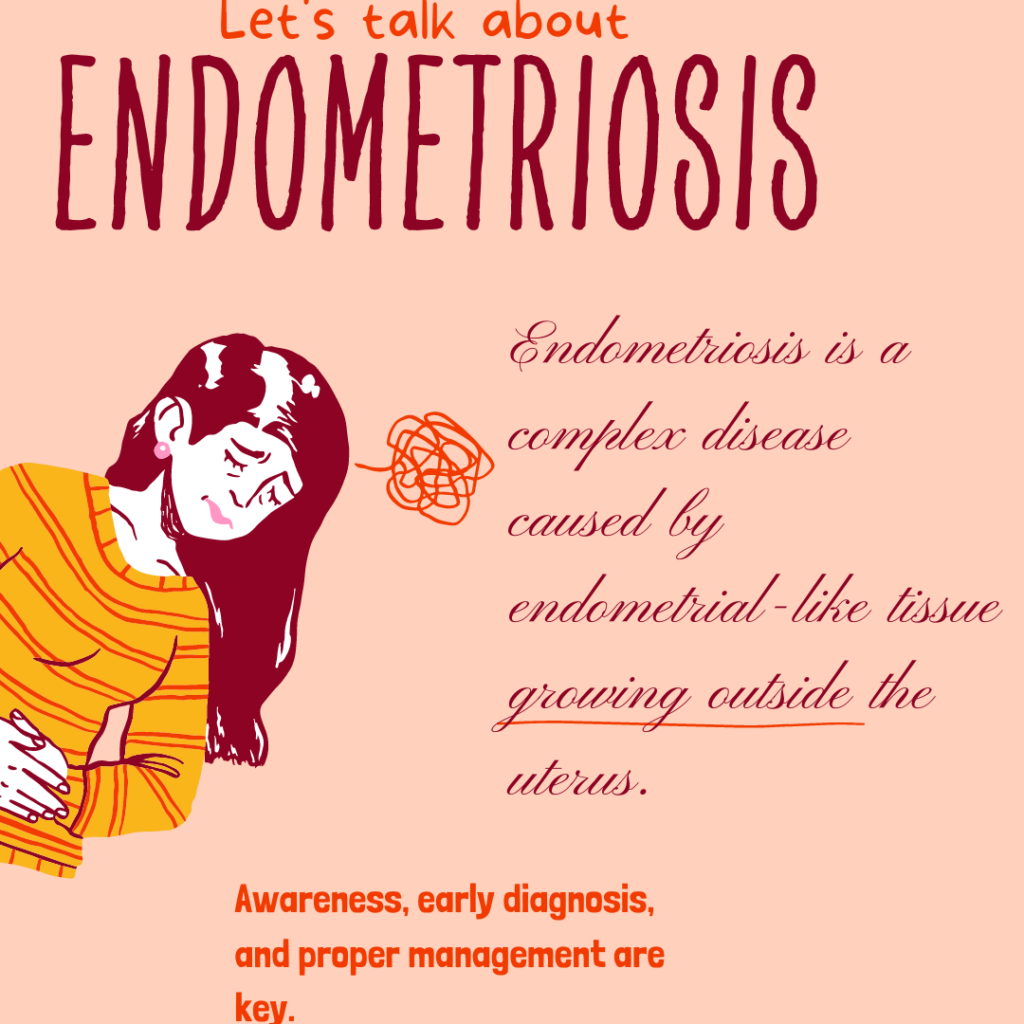Endometriosis is a condition marked by the presence of tissue resembling endometrial (uterine lining) outside the uterus.

Endometriosis Awareness Month is held each year in March to raise awareness of the ailment, which the World Health Organization estimates affects 190 million women worldwide. It is a chronic condition that causes excruciating, life-altering agony during periods, sexual activity, bowel and/or bladder movements, chronic pelvic discomfort, stomach bloating, nausea, exhaustion, and occasionally depression, anxiety, and infertility.
Endometriosis has substantial social, economic, and public health effects. Due to extreme pain, exhaustion, melancholy, anxiety, and infertility, it might lower the quality of life. Some endometriosis patients are incapacitated by excruciating pain that keeps them from going to work or school. In these circumstances, treating endometriosis can decrease absences from class or improve a person’s capacity to participate in the labor force.
Endometriosis-related pain can cause sex to be avoided or interrupted, which can have an impact on the sexual health of those who experience it and/or their partners. By promoting their human right to the highest standard of sexual and reproductive health, quality of life, and general well-being, addressing endometriosis will empower those who are impacted by it.
The need for an awareness month
The general population and the majority of front-line healthcare professionals are frequently unaware that unpleasant and life-altering pelvic pain is not normal, which results in a normalization and stigmatization of symptoms as well as a large delay in diagnosis in many countries.
Due to the lack of knowledge about endometriosis among primary healthcare practitioners, patients who could benefit from medical symptomatic therapy are not often given therapies. Delays in diagnosis frequently prevent patients from receiving non-steroidal analgesics (painkillers), oral contraceptives, and progestin-based contraceptives in a timely manner.
Access to specialized surgery for people who require it is subpar because of the constrained capacity of health systems in many nations. Furthermore, particularly in low- and middle-income nations, there aren’t enough multidisciplinary teams equipped with the diverse set of abilities and tools required for the early identification and successful treatment of endometriosis. Although primary healthcare providers should be involved in endometriosis screening and basic management, there is a shortage of screening and reliable prediction tools for patients and communities.
Also, there are a lot of knowledge gaps, and non-invasive diagnostic procedures, as well as pregnancy-unavoidable medical treatments, are needed. Depending on the symptoms, lesions, desired result, and patient preference, a patient may receive treatment with medication or surgery. Common treatments include painkillers, non-steroidal anti-inflammatory drugs, and contraceptive steroids. These must be cautiously prescribed and closely watched to prevent any negative side effects.
Treatment available for endometriosis
In order to change the hormonal conditions that encourage endometriosis, medical treatments for endometriosis concentrate on either lowering estrogen levels or raising progesterone levels. Progestins, GnRH analogs, and the combined oral contraceptive pill are some of these medical treatments.
All of these treatments have side effects, none of which completely cures the condition, and endometriosis-related symptoms can occasionally, though not usually, return after the medication is stopped. The choice of treatment is influenced by the patient’s effectiveness, unfavorable side effects, long-term safety, expenses, and accessibility.
Since most modern hormone treatments interfere with ovulation, they are not recommended for endometriosis patients who want to become pregnant.
Endometriosis lesions, adhesions, and scar tissue can all be removed surgically. However, the depth of the disease is frequently a factor in whether efforts to lessen pain sensations and boost pregnancy chances are successful. In addition, anomalies in the pelvic floor muscles can cause chronic pelvic pain, and lesions may return even after effective eradication.
Some individuals may benefit from physiotherapy and complementary therapies for central sensitization, secondary alterations of the pelvis, particularly the pelvic floor, and these conditions.
Laparoscopic surgical excision of endometriosis, ovarian stimulation with intrauterine insemination (IUI), and in vitro fertilization (IVF) are available treatments for infertility caused by endometriosis; however, success rates differ.
Endometriosis may coexist with other conditions that call for diagnosis and treatment. In order for the treatment to be most effective, multidisciplinary treatments addressing various symptoms and overall health should involve a variety of specialists, in complementary and alternative medicine, general practitioners, psychologists, and gynecologists.